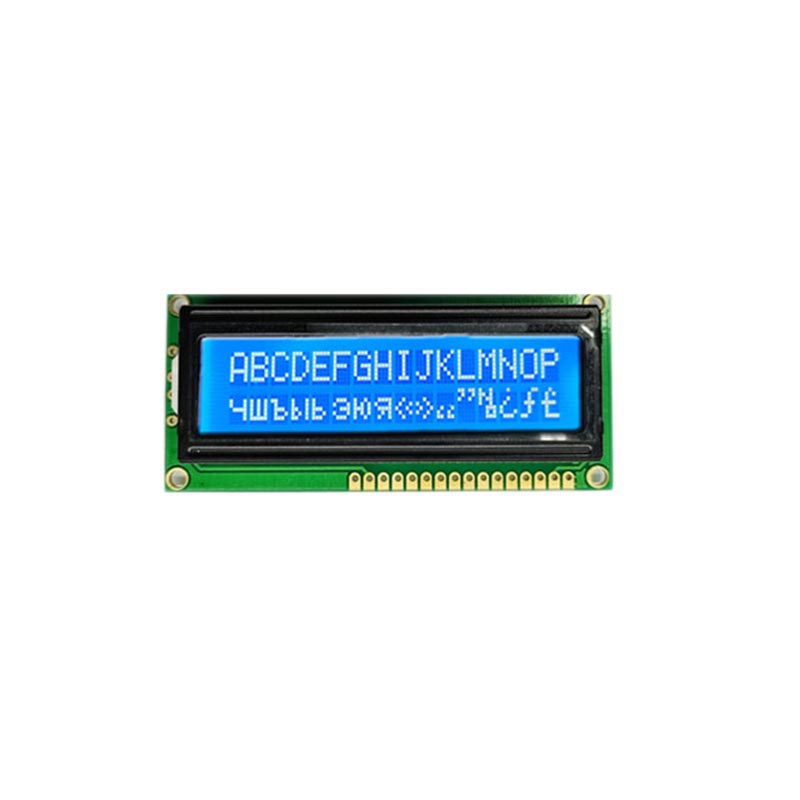Why Is a Character LCD Display Still the Most Reliable Visual Interface Today?
2025-11-21
A Character LCD Display remains one of the most stable, energy-efficient, and cost-effective human-machine interface (HMI) technologies used across industrial, commercial, and consumer equipment. From smart home devices and test instruments to medical systems and automation controllers, its clarity, low power consumption, and long lifespan make it a preferred choice where dependable text-based communication is required.
What Defines a Character LCD Display and Why Does It Remain Widely Used?
A Character LCD Display is a matrix-based liquid crystal module designed to output letters, numbers, and symbols in fixed positions. Unlike graphical LCDs, which display flexible pixel-based content, character modules arrange data in predefined rows and columns (e.g., 16×2, 20×4). Its strong readability, low complexity, and ultra-low energy requirements allow it to thrive in environments where fast, clear, and consistent information output is required.
Why This Technology Continues to Lead in Practical Applications
Character LCD Displays remain essential because they solve several recurring challenges faced by OEMs:
-
Power efficiency: Suitable for battery-powered and continuously operating systems.
-
High durability: Resistant to vibration, temperature fluctuation, and long operational cycles.
-
Low implementation cost: Simplifies integration with microcontrollers using common interfaces such as parallel, I²C, and SPI.
-
Consistent readability: Stable output under bright sunlight or dark room environments with options such as LED or EL backlights.
-
Long product lifecycle: Ideal for industries requiring component stability over 10+ years.
Core Product Parameters
Below is a concise technical overview of standard Character LCD Display specifications typically provided by Jingda:
| Parameter Category | Specification Details |
|---|---|
| Display Format | 8×2, 16×1, 16×2, 20×2, 20×4, 40×2, 40×4 |
| LCD Type | TN, STN, FSTN, FFSTN |
| Polarizer Mode | Positive / Negative |
| Driving Method | 1/4 or 1/16 duty, 1/2 or 1/5 bias |
| Backlight Options | LED (white, blue, yellow-green), EL, no backlight |
| Viewing Angle | 6 o’clock, 12 o’clock, and wide-view variants |
| Interface | Parallel, I²C, SPI |
| Operating Temperature | –20°C to 70°C standard; extended range –30°C to 80°C |
| Storage Temperature | –30°C to 80°C |
| Controller IC | HD44780 or compatible chipsets |
| Power Consumption | Typically 1–3 mA (with LED backlight variable) |
This structured configuration allows consistent performance whether installed in industrial boards, medical analyzers, diagnostics equipment, or handheld terminals.
How Does a Character LCD Display Work and What Features Make It Advantageous?
At its core, a Character LCD Display operates by manipulating liquid crystal molecules between transparent electrodes. Once electrified, the molecules shift orientation, controlling how light passes through the screen to form visible symbols. Combined with a backlight or reflective polarizer, the module provides sharp contrast for text-based output.
How Its Structure Enables Performance Stability
The internal layout of a Character LCD Display consists of:
-
A fixed character generator ROM
-
A liquid crystal cell with precise electrode mapping
-
A controller/driver IC
-
Optional backlighting
-
Polarizers for light manipulation
This configuration ensures that every character—letters, numbers, or symbols—maintains consistent shape and clarity, regardless of operating conditions.
Key Functional Advantages
-
Consistent readability across environments
High-contrast STN or FSTN layers ensure clarity under sunlight or low-light conditions. -
Low hardware requirement
Works with minimal processing power; compatible with most microcontrollers. -
Long operational lifespan
Ideal for machines requiring continuous display for 7–10 years without degradation. -
Wide temperature endurance
Suitable for outdoor and industrial environments. -
Stable supply chain availability
Unlike high-end TFT panels with frequent model discontinuation, character modules have long lifecycles.
This engineering reliability is why many industries continue to choose character modules for mission-critical systems.
Why Does the Market Still Prefer Character LCD Displays and What Future Trends Are Emerging?
Why Industry Continues to Depend on Character LCD Displays
The global demand persists because:
-
Many systems require text-only output, making graphical displays unnecessary.
-
Manufacturing and industrial equipment prioritize longevity over aesthetics.
-
Maintenance technicians prefer simple and predictable interfaces.
-
Devices with strict energy limits (solar systems, portable analyzers, metering devices) rely on low power screens.
Even with the rising adoption of TFT and OLED solutions, Character LCD Displays maintain strong relevance due to unmatched robustness and lower total cost of ownership.
Future Trends Shaping Character LCD Technology
-
Ultra-wide temperature capability
Enhanced liquid crystal materials will support operation below –40°C and above 85°C. -
Improved wide-view polarizer options
FSTN-based wide-angle displays are becoming more common for handheld applications. -
Higher brightness and optimized LED efficiency
Next-generation LED arrays will reduce power consumption further. -
More compact and integrated modules
Future versions may consolidate controller ICs and reduce PCB footprint. -
Customizable fonts and Unicode expansion
Increasing demand for multilingual displays will accelerate ROM customization. -
Hybrid solutions
Character TFT overlays that simulate classic character layouts while supporting lightweight graphical icons.
These advancements ensure that the Character LCD Display remains a strong contender even as display technologies evolve.
What Are the Most Common Questions About Character LCD Displays?
Q1: Why does a Character LCD Display sometimes show faint or missing characters?
A: This typically results from incorrect contrast voltage, insufficient power supply, or a misconfigured initialization sequence. Adjusting the contrast pin, ensuring stable 5 V or 3.3 V input, and verifying the microcontroller initialization code generally resolves the issue. In harsh environments, prolonged exposure to extreme temperatures may also affect liquid crystal performance, so proper module selection for outdoor ranges is essential.
Q2: What is the ideal interface method for stable communication with a Character LCD Display?
A: The parallel interface remains the most reliable because it directly matches the HD44780 protocol, minimizing timing complications. However, I²C or SPI adapters are preferred for compact devices that require fewer microcontroller pins. These serial options reduce wiring complexity while maintaining stable data transfer when implemented with proper timing guidelines.
Why Jingda Is a Trusted Partner for High-Quality Character LCD Displays
Across global industries, the demand for Character LCD Displays continues to grow because of reliability, clarity, efficiency, and long product lifecycle. The combination of stable operation, flexible configurability, and dependable readability ensures that this display type remains essential for manufacturers requiring long-term performance.
Jingda provides high-precision Character LCD Display modules built with strict quality control, advanced polarizer options, durable backlights, and multiple interface choices. With deep engineering expertise and strong production capacity, the company supports OEMs seeking dependable long-term supply and custom-tailored solutions.
For professional consultation, technical guidance, or product customization, contact us to learn how Jingda can support your next project with reliable and well-engineered Character LCD Display solutions.



